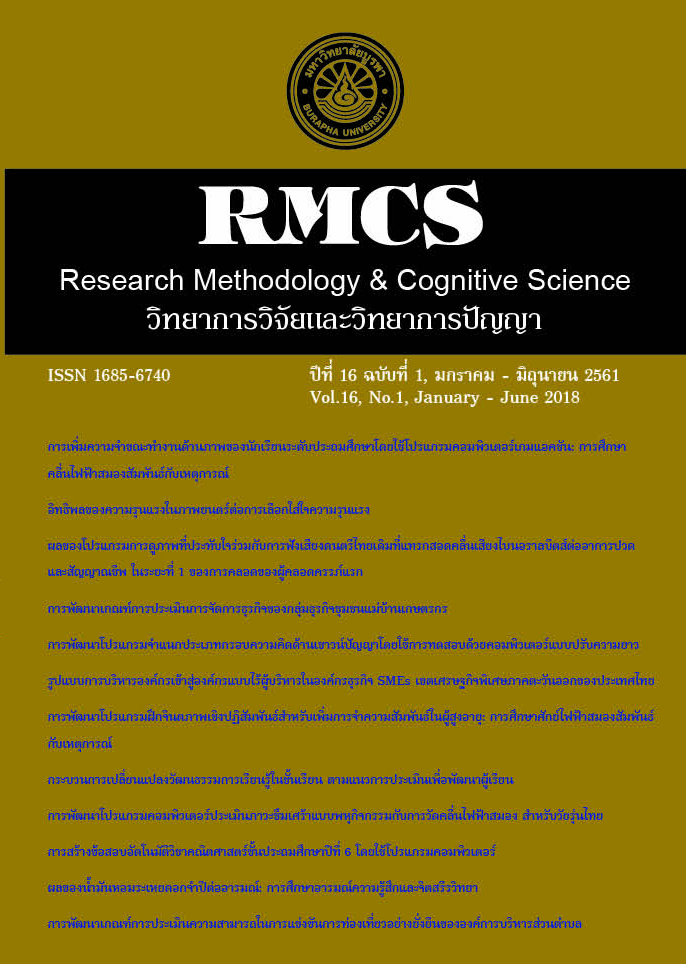The Changing Process of Classroom Learning Culture by Implementing Formative Assessment
Main Article Content
Abstract
In order to achieve the educational reform, it is necessary to start in the classroom where teachers have to change the traditional classroom culture into the new one. This research aimed (1) to compare the traditional classroom learning culture and the new classroom learning culture in five aspects: (a) the attitude and behavior of teachers, (b) the attitude and behavior of students, (c) the interaction between teachers and students, (d) interaction between students and students,
and (e), the classroom environment; (2) to synthesize the process of change in the learning culture in the classroom by implementing formative assessment; and (3) to study the effects of applying the process of change in the learning culture in the classroom by implementing the formative assessment of student outcomes. The target group consisted of teachers, and Grade two and Grade four students of Ban Ko Kao School, Surin Province, from the 1st semester of academic year 2016. Video recordings and interview forms were used to collect data. Qualitative data were analyzed by content analysis; quantitative data were analyzed by computing means, standard deviations, and percentages.
The results revealed that:
1. The comparative analysis of learning culture in the classroom indicated that the traditional classroom culture possessed the following characteristics: (a) teachers emphasized a transfer of knowledge to students; (b) students learned new knowledge by rehearsal; (c) students did not participate in classroom learning; (d) students did not help their classmates; and (e) the classroom environment was stressful. The new classroom learning culture presented the following characteristics: (a) teachers were facilitators; (b) students acquired new knowledge by doing; (c) students bravely shown ideas or ask teachers; (d) students helped their classmates; and (e) students were happy to learn.
2. The synthesis of the process of changing classroom learning culture showed that there were six steps: (a) establishing inspiration among directors; (b) changing the attitude of teachers and in student learning; (c) applying the learning process integrated with formative assessment; (d) coaching and monitoring; (e) organizing the professional learning community; and (f) taking the lessons studiously.
3. It was found that, after applying the six steps, students in Grade two and Grade four had learning outcomes of 81.37% and 85.11%, respectively. Moreover, teachers were satisfied at the highest level. Finally, students were, at a high level, satisfied with having the learning activities integrated with formative assessment.
Article Details
References
ไพฑูรย์ สินลารัตน์. (2558). ปฎิรูปการเรียนรู้ : ปฏิรูปการศึกษากลับทางจากล่างขึ้นบน. กรุงเทพฯ: พี เอ ลีฟวิ่ง.
สถาบันวิจัยเพื่อการพัฒนาประเทศไทย. (2556). รายงานวิจัยฉบับสมบูรณ์การจัดทำยุทธศาสตร์การปฏิรูปการศึกษาขั้นพื้นฐานให้เกิดความรับผิดชอบ.กรุงเทพฯ: มูลนิธิสถาบันวิจัย
เพื่อการพัฒนาประเทศไทย.
สุวิทย์ มูลคำและอรทัย มูลคำ. (2551). 20 วิธีจัดการเรียนรู้เพื่อพัฒนาคุณธรรม จริยธรรม ค่านิยม และการเรียนรู้โดยการแสวงหาความรู้ด้วยตนเอง. (พิมพ์ครั้งที่ 7). กรุงเทพฯ:
โรงพิมพ์ภาพพิมพ์.
Alexander, B. (2006). Web 2.0: A new wave of innovation for teaching and learning?. Educause Review, 41(2), 32-44.
Bose, J., & Rengel, Z. (2009). A model formative assessment strategy to promote student-centered self-regulated learning in higher education. USChina Education Review, 6(12), 29-35.
Brookhart, S. M., Moss, C. M., & Long, B. A. (2009). Promoting student ownership of learning through high-impact formative assessment practices. Journal
of MultiDisciplinary Evaluation, 6(12), 52-67.
Cheng, E. W., Li, H., Love, P., & Irani, Z. (2004). A learning culture for strategic partnering in construction. Construction Innovation, 4(1), 53-65.
Conner, M. L., & Clawson, J. G. (2004). Creating a learning culture. Cambridge: Cambridge University Press.
Dibbon, D. (2000). Diagnosing the extent of organisational learning capacity in schools. Advances in Research and Theories of School: Management and Educational Policy, 4(10), 211-236.
Di Iorio, C. K. (2006). Measurement in health behavior: methods for research and evaluation (Vol. 1). San francisco: John wiley & sons.
Hattie, J., & Timperley, H. (2007). The power of feedback. Review of Educational Research, 77(1), 81-112.
Heritage, M. (2010). Formative assessment: Making it happen in the classroom. California: Corwin Press.
Koehler, C. M., Faraclas, E., Giblin, D., Moss, D. M., & Kazerounian, K. (2013). The nexus between science literacy & technical literacy: A state by state analysis of engineering content in state science standards. Journal of STEM Education: Innovations and Research, 14(3), 5-12.
Mackay, A. (2010). Motivation, ability and confidence building in people. New York: Routledge.
Melmer, R., Burmaster, E., & James, T. K. (2008). Attributes of effective formative assessment. Washington DC: Council of Chief State School Officers.
Popham, J. (2008). Transformative assessment association for supervision and curriculum development. Retrieved from www. ascd. org.
Roberts, A. (2013). STEM is here. Now what?. Technology and Engineering Teacher, 73(1), 22-27.
Takeuchi, R., Lepak, D. P., Wang, H., & Takeuchi, K. (2007). An empirical examination of the mechanisms mediating between high-performance work systems and the performance of Japanese organizations. Journal of Applied Psychology, 92(4), 1069-1083.
Wass, V., Van der Vleuten, C., Shatzer, J., & Jones, R. (2001). Assessment of clinical competence. The Lancet, 357(9260), 945-949.
Wiliam, D. (2008). Changing classroom practice. Educational Leadership, 65(4), 36-42.
